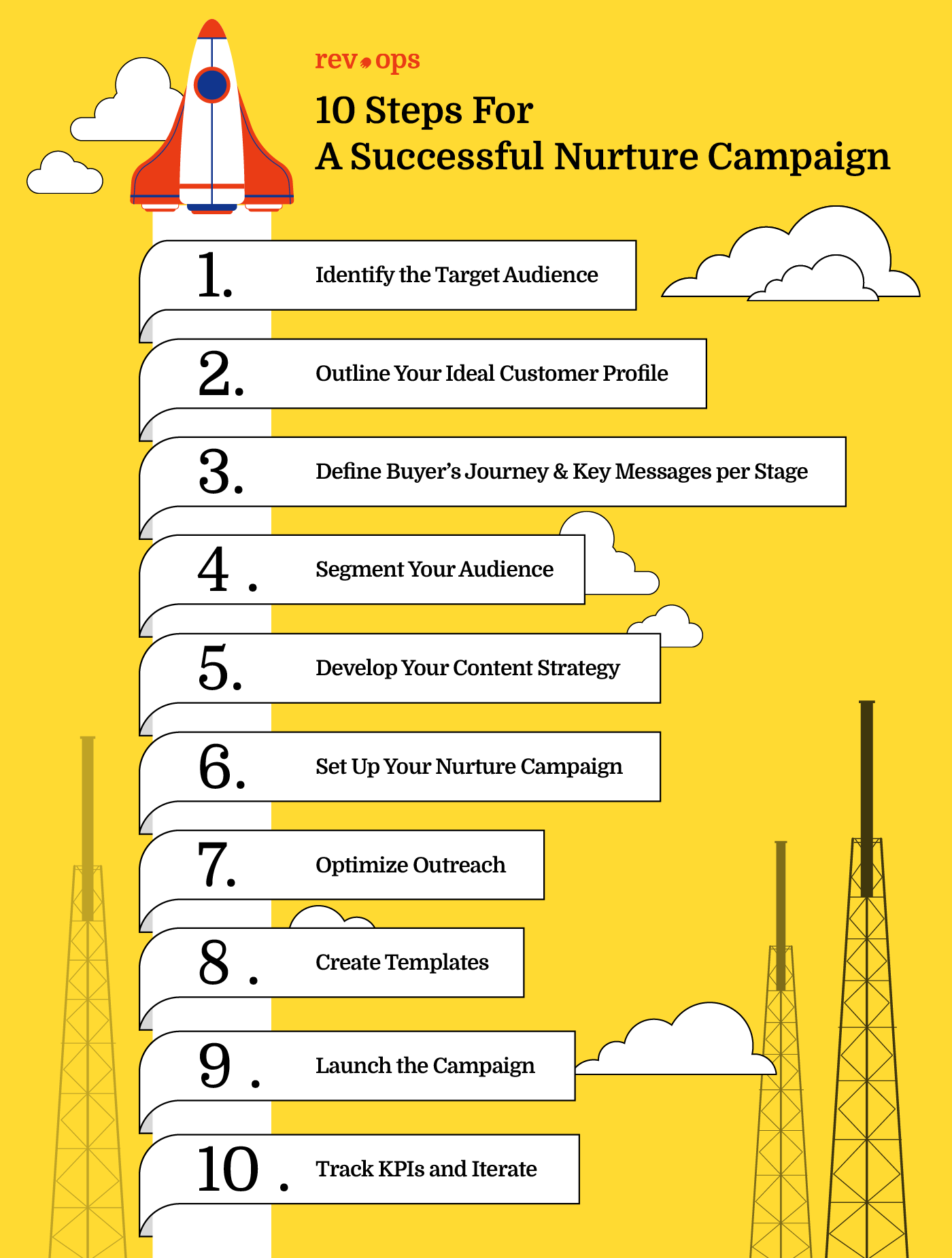Nurture Campaigns: Your Warm Email Blanket: Nurture campaigns are vital for engaging leads and moving them through the sales funnel, creating lasting relationships that turn leads into loyal customers.
Data-Driven Decisions Boost Sales Success: Companies that effectively nurture leads see a significant increase in sales-ready leads and larger purchase sizes, highlighting the cost-effectiveness of these campaigns.
Customize Everything for Your Leads: Segmenting your audience and tailoring content to their specific needs ensures relevant communication, enhancing engagement and improving overall campaign performance.
Balance Automation with a Human Touch: While automation streamlines outreach, maintaining personalization is crucial. Regular check-ins from real people keep the communication warm and engaging.
Iterate and Improve for Long-Term Success: Nurturing campaigns require continuous testing and adaptation. Regularly analyzing performance metrics helps optimize strategies for ongoing relationship building.
Feel like you're sending cold emails into the void? Nurture campaigns can help solve that. These campaigns are like having an ongoing conversation with your leads, warming them up and guiding them through the sales funnel until they’re ready to convert—and ideally stick around for the long haul.
Let’s break down exactly how you can set up a killer nurture campaign in 10 steps that will boost conversions, keep your audience engaged, and help build long-term customer relationships.
What Is a Nurture Campaign?
At its core, a nurture campaign is a series of touchpoints, whether through email, social media, or even SMS, aimed at moving leads through your sales funnel to become paying (and ideally loyal) customers. Think of it as a process for educating, engaging, and qualifying leads based on their behavior, interests, and pain points.
But it’s not just about sending content—it’s about sending the right content at the right time, based on what you know about your leads.
Impact of Nurture Campaigns
You might wonder—how much of a difference do these campaigns make? The data speaks for itself.
According to Forrester, companies that excel at lead nurturing generate 50% more sales-ready leads at 33% lower costs. Even better, nurtured leads make 47% larger purchases, says Annuitas Group.
Long-Term Loyalty
Nurture campaigns aren't just for net new leads. Long-term loyalty requires consistent relationship management with your existing customer base. And in today's market shift toward profitability over growth at all costs, expansion, upsells, and retention of your customer base are increasingly important in driving revenue.
Consider post-purchase engagement through educational content, exclusive offers, and personalized recommendations to keep customers invested in your brand for the long haul.
10 Best Practices for a Successful Nurture Campaign
1. Identify the Target Audience
Before diving in, you need to know who you’re talking to. Start by defining your Ideal Customer Profile (ICP) based on demographic, firmographic (if you’re in B2B), and psychographic data. RevOps teams should dig into analytics to pinpoint the characteristics that define your most valuable customers.
2. Outline Your Ideal Customer Profile (ICP)
Next, take that research and sketch out your ICP. The more detailed, the better. What are their buying cycles? Are they decision-makers or do they have to pitch your product to others in the organization? A clear ICP helps you segment leads effectively, which is key for personalized nurturing.
3. Define the Buyer’s Journey and Key Messages for Each Stage
The buyer’s journey has three stages: Awareness, Consideration, and Decision. Each stage requires different messaging. Early on, they’re looking for solutions to a problem, but as they move down the funnel, they need reassurance that your product or service is the best choice.
Here’s a simple approach:
- Awareness Stage: Educational content like blogs, webinars, and whitepapers
- Consideration Stage: Case studies, customer testimonials, and product comparisons
- Decision Stage: Free trials, personalized demos, and discount offers
4. Segment Your Audience
Not all leads are the same, so don’t treat them as such. Segment your audience based on criteria like industry, company size, behavior, or engagement level. This allows you to tailor content to specific groups, boosting relevance and engagement.
5. Develop Your Content Strategy
Now that you know who you’re targeting, what kind of content will you send? Your content strategy should be aligned with the buyer’s journey and tailored to each segment.
Here’s a breakdown:
- Educational Content (e.g., blog posts, webinars) for leads in the early stage.
- Drip Campaigns to deliver a steady flow of information based on triggers or time intervals.
- Re-engagement Campaigns to rekindle interest among cold leads.
Drip Campaigns vs. Nurture Campaigns
Drip campaigns are often time-based and automated, sending pre-scheduled emails regardless of engagement. Nurture campaigns, on the other hand, are more dynamic, reacting to how a lead interacts with your content. Use nurture campaigns when you want to adjust messaging based on lead behavior or milestones.

6. Set Up Your Nurture Campaign
The tech you use is just as important as the content you deliver. A CRM is the foundation for tracking interactions and segmenting leads, but it should also help you measure effectiveness and automate outreach.
If you’re growing quickly, CRMs like HubSpot, Salesforce, and Oracle are great enterprise solutions. For smaller setups, consider Pipedrive or Monday.com, which offer more affordable, scalable options.
These are a few of my favorite CRMs and lead management platforms on the market:
7. Optimize Outreach
Automation is your friend, but don’t rely on it too much—no one likes robotic emails. Use tools for lead nurturing automation, like Klaviyo or HubSpot, but add personal touches. And always A/B test your subject lines and email content to see what works best.
Look for email platforms that offer:
- Personalization: Tailored messaging based on lead data
- Analytics: Insights into open rates, click-throughs, and conversions
- Lead Scoring: To prioritize high-engagement leads
8. Create Templates
Instead of reinventing the wheel every time, create email templates for your nurture sequences. Michael Pozdnev offers great e-commerce email templates, but you can find industry-specific ones that align with your audience.
9. Launch the Campaign
Once your templates are ready and your CRM is set up, it’s time to go live. Test everything before launching—emails, landing pages, and CTAs. And remember, nurturing isn’t a one-and-done process. Monitor campaign performance regularly and tweak it based on your KPIs.
10. Track KPIs and Iterate
Track key performance indicators (KPIs) like conversion rates, engagement, lead quality, customer acquisition cost (CAC), and lifetime value (LTV). Start simple—use a spreadsheet if you’re not ready for advanced analytics software.
According to Epsilon, 80% of consumers are more likely to make a purchase when brands offer personalized experiences.
Common Mistakes to Avoid in Nurture Campaigns
1. Over-Automation
Automating too much can make your outreach feel cold and impersonal. Even with automation, it’s critical to add the human touch, like a check-in email from a real person now and then.
2. Content Overload
Bombarding leads with too much content too frequently can overwhelm them. Instead, focus on quality over quantity. Segment your audience to ensure you’re sending relevant content at the right pace.
Final Thoughts: Keep Testing and Iterating
Running a nurture campaign isn’t a one-time task. It’s an ongoing process that requires regular testing, iteration, and optimization. Keep an eye on your data, adjust your approach as needed, and focus on building real, lasting relationships with your customers.
By following these steps, you’ll not only boost your conversions but also build trust and loyalty with your leads—setting the foundation for long-term growth.
Ready to take your nurture campaigns to the next level? Sign up for The RevOps Team newsletter and get expert insights delivered straight to your inbox.


